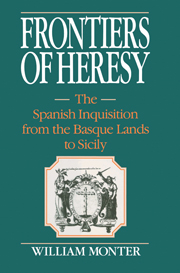Book contents
- Frontmatter
- Contents
- List of maps and figure
- List of tables
- Preface
- PART 1 THE HOLY OFFICE OUTSIDE CASTILE
- PART 2 ARAGONESE TRIBUNALS
- PART 3 ARAGONESE HERESIES
- PART 4 “MIXED CRIMES” IN ARAGON
- PART 5 RECESSIONAL
- 14 The eclipse of Aragon, 1630–1730
- Conclusion: one king, one law, one faith
- APPENDICES
- Glossary
- Index
- CAMBRIDGE STUDIES IN EARLY MODERN HISTORY
Conclusion: one king, one law, one faith
Published online by Cambridge University Press: 24 October 2009
- Frontmatter
- Contents
- List of maps and figure
- List of tables
- Preface
- PART 1 THE HOLY OFFICE OUTSIDE CASTILE
- PART 2 ARAGONESE TRIBUNALS
- PART 3 ARAGONESE HERESIES
- PART 4 “MIXED CRIMES” IN ARAGON
- PART 5 RECESSIONAL
- 14 The eclipse of Aragon, 1630–1730
- Conclusion: one king, one law, one faith
- APPENDICES
- Glossary
- Index
- CAMBRIDGE STUDIES IN EARLY MODERN HISTORY
Summary
The best recent synthesis describes the Spanish Inquisition in 1520 as an “instrument of royal policy, effective agent of centralization and defense against the centrifugal action of the fueros” which had deployed its tribunals for a “satisfactory occupation of the political and social space” capable of imposing its presence throughout Spain. The Holy Office succeeded in making itself respected everywhere, enforcing strict obedience to orthodox Catholic doctrine without employing excessive physical cruelty. Nowhere was its task more difficult than in the various parts of the Crown of Aragon.
When King Ferdinand first introduced the new Inquisition into his hereditary domains in the 1480s, it had exactly the same goals as in Castile: the eradication of Jewish practices among the conversos. But the political context of the Holy Office was vastly different in the Crown of Aragon, a federation of states which cherished their extensive liberties and where converted Jews had intermarried with prominent Old-Christian families.
- Type
- Chapter
- Information
- Frontiers of HeresyThe Spanish Inquisition from the Basque Lands to Sicily, pp. 321 - 325Publisher: Cambridge University PressPrint publication year: 1990

